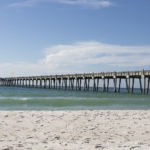UWF oil spill team ready to analyze water and sand samples
Researchers at the University of West Florida, led by Richard Snyder, director of the Center for Environmental Diagnostic and Bioremediation, are ready to start analyzing and releasing data after four weeks of collecting sand and water samples from around the Pensacola area.
The difficulty in obtaining a sample of oil from the spill site, essential for confirming the analytic work, delayed the team’s ability to get up to speed quickly, he told commissioners in Santa Rosa County Thursday. With a sample now in the lab, the team’s goal is to begin processing the four weeks of samples already in hand and then to start sampling sand and water on Monday, analyze the samples in the lab and then release findings on Tuesday or Wednesday of the same week.
Since the initial April 20 Deep Horizon oil well explosion, the well about 50 miles off the Louisiana delta has been sending a river of crude oil in the Gulf waters every day. So far, BP’s efforts to stem the flow have been unsuccessful Thursday’s “top kill” maneuver appears to be holding for now.
Research at UWF will be able to provide evidence if oil from the spill has arrived here. Tar balls already are being collected, but the question is whether or not there is oil dissolved in the water. Crews have been collecting samples from four sites on Santa Rosa Island, two sites on Perdido Key and from off shore to create a baseline from which to study incoming samples. Also, UWFÂ researchers have been collecting fish samples.
“We are looking for the oil you can’t see. We are chemically analyzing these samples so that we are not relying on visual analysis,” said Snyder.
While he told commissioners this area likely will not see the oil now smothering Louisiana’s coastline, Snyder said the large volumes of dispersed oil out in the Gulf are a potential threat, and tar balls are the most likely impact to be seen along the shores of Northwest Florida.
“The visible oil on the surface is being tracked, but not the dispersed oil. It is dissolving in water a mile deep, and we do not know where it is going,” he said. Oil that settles in the deepest parts where the temperature equals that of a refrigerator will degrade little or not at all and continue to threaten the environment.
While any action taken to clean up the spill has complications, he said the use of almost 800,000 gallons of dispersants in the gulf is “unprecedented” and the long-term impact is unknown. Though the dispersants are toxic, as is the crude oil, the dispersants do make the oil easier for bacteria to break down.
“There is a lot of oil that has come out of the sea floor. How much of that ends up south of us, southwest of us and low in our shoreline, we really do not have a good idea,” he said.
“This will be a long-sustained impact. We are going to be living with this for a while.”
For more information about the research under way at UWF, contact Snyder at (850) 474-2806 or e-mail rsnyder@uwf.edu or visit http://www.uwf.edu/rsnyder. The UWF Oil Spill Response Web site is http://uwf.edu/UWFMain/press/oilspill.
By Susie Forrester, University Marketing Communications


